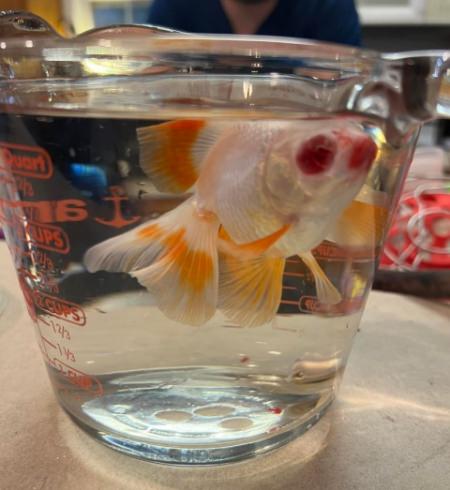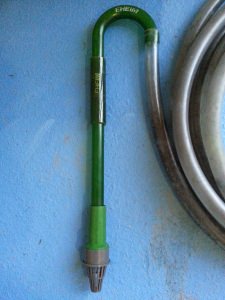| Back to Back Issues Page |
 |
|
The Goldfish Gazette, Issue #103 Water Change Dangers July 31, 2022 |
Goldfish Care TipsA Free Monthly Resource For Goldfish Enthusiasts In This Issue Water changes are an important part of keeping our Goldfish healthy, but with them comes dangers. Water Change Dangers
Siphon HosesMany beginners underestimate the power of a siphon, not realizing that the weight of water in the hose can far exceed the weight of their fish. The sudden accidental blocking of the hose by a curious fish creates a high vacuum that often causes life threatening injuries.A soft bodied Goldfish is no match for even a small siphon hose. The image above was copied from a Facebook post and shows a rather nice Broadtail Moor that has lost both eyes after being sucked into a siphon hose. It only takes a second of inattention or a distraction to cause horrific injuries. We all like our Goldfish to interact with us, but then expect them to keep away from a siphon hose. Goldfish only see a siphon hose as another possible food source. The safest way to operate a siphon is to have a physical barrier on the hose intake end.
An added bonus of using these is I can hang them over the side of an aquarium and get on with doing something else knowing the fish are safe, and the water will stop siphoning once the level I have predetermined by the filter outlet tube length, is reached. This system also works for ponds where the danger is greater because of the size of the hoses used and the longer time it takes to empty a pond. As a side note, if a fish does get injured, immediately place it into a mild salt bath of two teaspoons of aquarium salt per gallon, and keep the water pristine. The salt stops the fish losing electrolytes from the injuries. Water additivesMost domestic water supplies are treated with various chemicals, but the ones we are concerned about are chlorine and chloramine.Both these chemicals burn the skin, and more importantly the delicate gill tissue which can lead to asphyxia. If, after a water change you notice your fish seem lethargic and are swimming at the surface, suspect chemical burning. The only thing you can do is double dose the water with water conditioner and add additional water aeration to keep the oxygen level as high as possible. A mild salt bath of one teaspoon of aquarium salt per gallon is also advisable. Water OverflowsA trap many have fallen into, including myself, is to forget to turn the hose tap off when refilling a pond or aquarium.An overfilled pond isn’t such a problem except when the total water volume is replaced with new water and the water conditioner has been diluted to low levels. The same remedial actions are required for chemical burning as for an aquarium. An overfilled aquarium is a disaster as water is very destructive to carpets, walls and floors. Water level indicators are available that send out a warning sound once the predetermined water level has been reached; very cheap insurance considering the potential cost to property and fish. Water TemperaturesThe last danger to consider when changing water is water temperatures. You can get away with larger temperature differences with single tailed varieties, but deep bodied fancy varieties are much less able to tolerate anything much greater than 5oF (2.8oC).Colder water is the problem as you can easily chill a deep bodied variety which can lead to swim bladder problems.
Comments? Ideas? Feedback? I'd love to hear from you. Just reply to this e-zine and tell me what you think, or what topics you want to be covered. Next Month's Topic Common Flaws in Pet Shop Fishwww.facebook.com/aboutgoldfish |
| Back to Back Issues Page |

 I attach canister filter outlet tubes to my siphon intake ends. They are already designed to stop fish from being sucked into a filter so are ideal for a siphon.
I attach canister filter outlet tubes to my siphon intake ends. They are already designed to stop fish from being sucked into a filter so are ideal for a siphon.